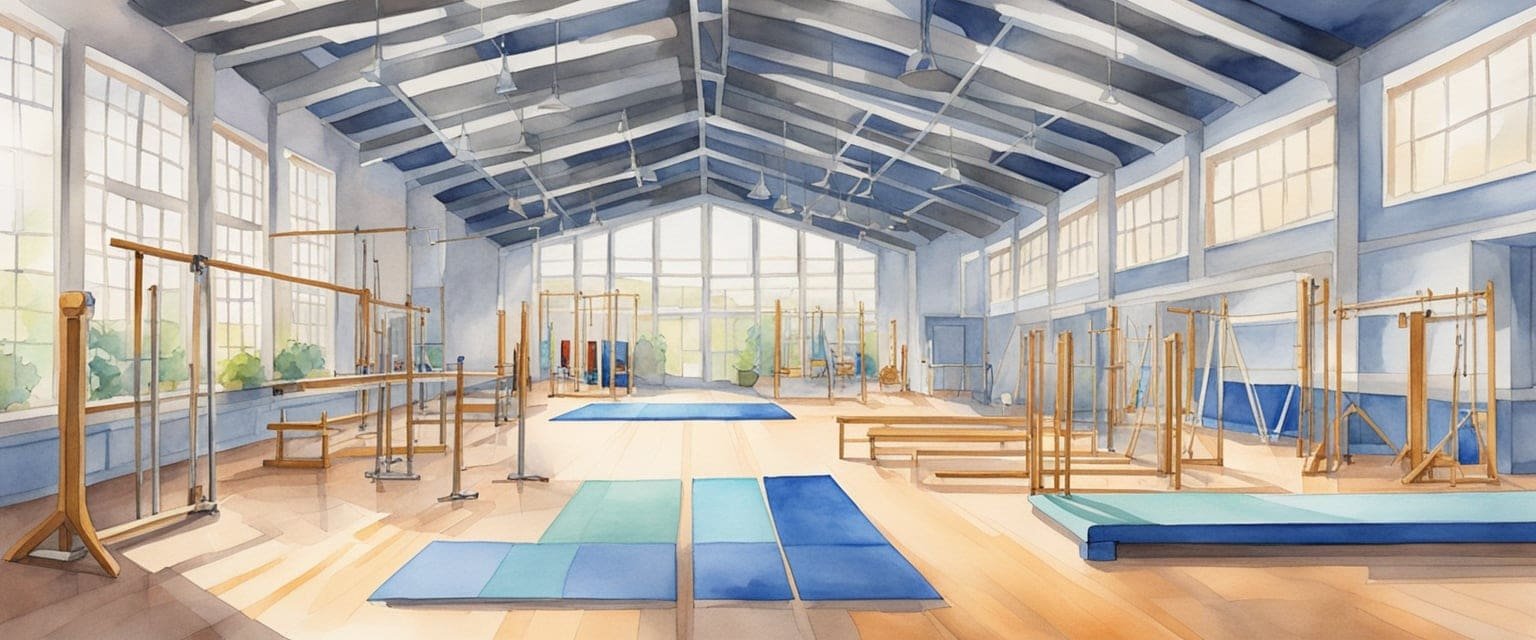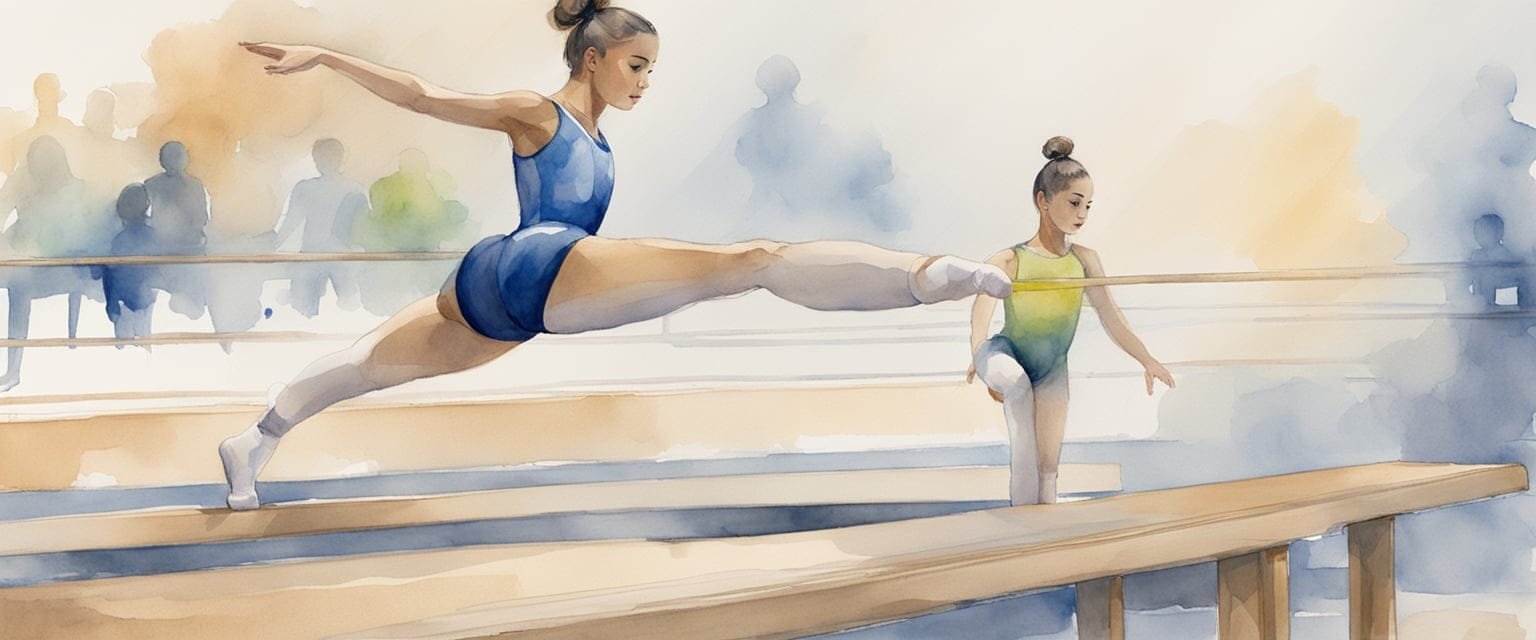Artistic gymnastics is one of the most exciting and challenging sports in the Olympics. In this ultimate guide to Olympic Artistic Gymnastics, I’ll explore everything you need to know about this incredible sport, from its rich history to the thrilling competition format used at the 2024 Paris Olympics. Whether you’re a longtime fan or just getting started, there’s so much to discover about the athletes and events that captivate millions around the world.

As I dive into the different elements of gymnastics, I’ll share insights on the various apparatus used in competition, how scoring works, and what it takes to train at the highest level. Understanding the journey of these dedicated gymnasts can really enhance your viewing experience, especially during major competitions.
I’m excited to bring you closer to the world of Olympic Artistic Gymnastics. Whether you want to impress friends with your knowledge or simply enjoy the sport more fully, this guide is here to help!
Key Takeaways
- Artistic gymnastics combines history, skill, and athleticism.
- Understanding scoring can improve your viewing experience.
- Learning about athletes can inspire you and deepen your appreciation for the sport.
History of Artistic Gymnastics

Artistic gymnastics has a rich history that reflects both its origins and its development as an Olympic sport. This section looks at how gymnastics started, its journey into the Olympics, and some of the legendary gymnasts who have made their mark in history.
Origins and Evolution
I find it fascinating that gymnastics dates back to ancient civilizations. The Greeks practiced exercises that focused on strength and flexibility, often in training for military purposes. Over time, gymnastics evolved into a formal sport, especially in 18th century Germany.
Friedrich Ludwig Jahn played a key role in this transformation by introducing apparatus like the parallel bars and the pommel horse. As gymnastics spread across Europe, it took on both physical and artistic elements, leading to the modern sport we see today.
The development of women’s gymnastics was particularly significant, especially during the 20th century when it gained popularity after World War II. This laid the foundation for gymnastics as an Olympic event.
Olympic Inclusion
The journey of gymnastics to the Olympics is another interesting aspect of its history. The sport was first included in the modern Olympic Games in Athens in 1896, but only for men. Women’s gymnastics became part of the Olympic program later, debuting in 1928 at the Amsterdam Games.
Since then, gymnastics has grown tremendously, reflecting cultural shifts and the dedication of athletes. Japan, China, and Ukraine have produced many world-class gymnasts, showcasing their skills on the Olympic stage.
The upcoming 2024 Paris Olympics is expected to feature groundbreaking routines, especially with athletes like Simone Biles and Suni Lee competing. Their talent exemplifies the evolution of gymnastics into a sport that celebrates athleticism and artistry.
Famous Gymnasts in History
Throughout gymnastics history, many athletes have made unforgettable contributions. Simone Biles is often hailed as one of the greatest gymnasts of all time. She has set numerous records and continues to inspire many with her incredible performances.
Suni Lee captured gold in the individual all-around at the Tokyo 2020 Olympics, showcasing her remarkable talent. Other notable gymnasts include Nadia Comaneci, who famously scored a perfect 10 at the 1976 Olympics, and Olga Korbut, who amazed the world with her daring routines in the 1970s.
These athletes not only brought attention to the sport but also set high standards for future generations. Their legacies continue to inspire young gymnasts worldwide, contributing to the ongoing popularity of artistic gymnastics.
Understanding the Sport
Artistic gymnastics is a dynamic sport that combines physical strength, flexibility, and creativity. It involves various disciplines, events, and specific terminology that define its unique characteristics.
Artistic Gymnastics Disciplines
Artistic gymnastics includes several key disciplines for both men and women. For men, the six apparatus are floor exercise, pommel horse, still rings, vault, parallel bars, and horizontal bar (high bar). Women compete on four apparatus: vault, uneven bars, balance beam, and floor exercise.
Each discipline requires specific skills, known as elements, which gymnasts practice to perfection. Routines are choreographed to showcase not only athletic ability but also artistry and grace. Successful routines are judged based on difficulty, quality of execution, and overall presentation.
Men’s vs. Women’s Events
Men’s and women’s events differ in both structure and apparatus. Men typically perform on six apparatus while women use four. This difference means that the routines and skills focused on may vary significantly between the genders.
In competitions, both men and women participate in individual and team events. I find the all-around competitions exciting, as gymnasts must perform across multiple apparatus. The qualifying round is crucial, as it determines who advances to finals based on their scores in each event.
Key Gymnastics Terms
Understanding gymnastics involves a variety of terms that describe routines and scores. The Code of Points is a guideline used by judges to evaluate performances. It details how elements are scored, with emphasis on difficulty and artistry.
Common elements include tumbling passes and dismounts, both of which are critical for scoring. A fall during a routine can lead to point deductions, affecting overall placement. Elements are often combined to form intricate routines that show a gymnast’s level of skill and creativity.
Knowing these terms enhances my appreciation of the sport and helps me follow competitions more closely.
The Olympic Competition Format
The format for Olympic Artistic Gymnastics is structured to create exciting competitions across multiple events. Understanding how each phase works helps fans and participants appreciate the journey to the medals.
Qualifying to the Olympics
Qualifying for the Olympics is a crucial step for gymnasts. Each National Olympic Committee (NOC) has the opportunity to send a limited number of athletes, often adhering to the two-per-country rule. This means only two gymnasts per gender can compete in the individual all-around and event finals if their country qualifies multiple spots.
There are various competitions leading up to the Olympics, including World Championships and Continental Championships. Results from these events determine which teams and individuals qualify. For example, the U.S. Women’s Team has consistently ranked high, securing their spot for the Paris Games.
Team Finals
During the team finals, the focus shifts to the team’s total score rather than individual performance. Teams typically consist of four gymnasts, with each athlete competing on different apparatuses. The top three scores from each apparatus count towards the team total.
Gymnasts perform in a specific order, following the Olympic order of events. This helps maintain rhythm and engagement among the audience. The team with the highest combined score earns the gold medal, with silver and bronze awarded to the next best teams.
All-Around Finals
In the all-around finals, individual gymnasts showcase their versatility across all four events: floor, vault, uneven bars, and balance beam. Each gymnast performs routines on every apparatus, aiming for the highest overall score.
During these finals, gymnasts are competing for individual glory. The format allows them to demonstrate their skills in different disciplines. The scores are cumulative, meaning every routine counts towards their final score for a chance at the medal podium.
Event Finals
The individual apparatus finals are where gymnasts shine on their best events. After qualifying rounds, the top eight gymnasts for each apparatus compete. This is an exciting opportunity for athletes to display their specialized skills.
In these finals, each gymnast performs without the pressure of a team score, allowing them to focus solely on their routines. The format is structured to crown champions for each apparatus, ensuring a highlight for both athletes and fans. This separation underscores the importance of individual talent within the broader context of Olympic gymnastics.
Scoring and Judging
In Olympic Artistic Gymnastics, scoring is a key part of understanding how athletes are evaluated. The scoring system combines two main scores: the Execution Score and the Difficulty Score. Let’s break down how these scores work and what factors influence them.
Elements of a Gymnastics Score
Each gymnast’s score is made up of two main parts: the E-score (Execution Score) and the D-score (Difficulty Score). The E-score starts at 10.0 and decreases based on the gymnast’s performance. This score reflects the execution of their routine, including precision and technique.
The D-score awards points for the difficulty of the elements performed in a routine. It includes various skills, combinations, and connection values that add to the overall difficulty. Gymnasts can achieve a higher D-score by incorporating challenging moves, which can lead to a higher final score.
The Deductions System
Deductions play a significant role in the scoring process. Judges observe each performance and apply penalties for mistakes. Common deductions include:
- Steps on landings
- Falls
- Bent knees
- Flexed feet
These mistakes can range from 0.1 to 1.0 points deducted depending on the severity. I find it interesting that even slight errors in form can significantly affect a gymnast’s E-score. The more precise the execution, the higher the score stays.
Execution vs. Difficulty
The difference between the E-score and D-score is crucial to understand. The E-score focuses on how well the gymnast executes their routine. This includes factors like fluidity, form, and overall presentation.
The D-score, on the other hand, considers the complexity and risk of the elements performed. A gymnast can achieve a high D-score with a challenging routine, but if their execution is poor, their E-score will drop, impacting their final score. Balancing both elements is key for athletes who want to excel in competition.
Apparatus Overview

Artistic gymnastics showcases incredible skill across various apparatuses. Each piece offers unique challenges and requirements for both men and women, making the competitions exciting to watch.
Vault
The vault is a thrilling event where gymnasts sprint down a runway, launch off a springboard, and execute flips and twists over a vaulting horse. Athletes need a combination of speed, power, and precision to succeed.
A perfect vault requires 3 key components:
- Approach Speed: Gaining momentum before takeoff.
- Body Control: Maintaining form during flight.
- Landing: Achieving a stable and controlled arrival on the mat.
In the finals, gymnasts perform two vaults, and the scores combine to determine their rankings. Watching the women’s vault final is especially exciting because of the high level of difficulty and precision.
Uneven Bars and High Bar
The uneven bars are a staple for female gymnasts. This apparatus features two horizontal bars at different heights. Athletes swing, twist, and release between the bars, showcasing strength and coordination.
On the other hand, the high bar is exclusively for men. Gymnasts perform similar movements but with a single elevated bar. Both events require:
- Strength: For swinging and holding onto the bars.
- Timing: To execute releases and catches successfully.
The bar routines during the finals are a true demonstration of athleticism, often leaving the audience in awe.
Balance Beam and Pommel Horse
The balance beam poses a significant challenge for female gymnasts. It is only 4 inches wide, requiring extraordinary balance and concentration. Routines often include jumps, turns, and acrobatic elements, showcasing both grace and strength.
In contrast, the pommel horse is a men’s event featuring two handles. Gymnasts perform circular movements with their legs while maintaining balance and control. Both pieces test:
- Balance and Coordination: Essential for executing difficult elements.
- Precision: Needed to avoid wobbles or falls.
The final routines on these apparatuses reflect the athletes’ hard work and dedication.
Floor Exercise
The floor exercise combines artistry with athleticism. Gymnasts perform a choreographed routine on a spring floor, which allows for higher jumps and dynamic movements. Both men and women face unique challenges during this event.
Key elements of a successful routine include:
- Strength: To perform tumbling passes and dance elements.
- Creativity: To express themselves through choreography.
During the finals, gymnasts need to score high on both difficulty and execution to stand out. The women’s floor exercise final is particularly captivating due to the combination of dance and acrobatics.
Rings and Parallel Bars
Rings are one of the most demanding events for male gymnasts. This apparatus tests strength and stability as athletes must hold themselves up while performing various movements. Key skills involve:
- Strength: Essential for keeping the body aligned.
- Control: Needed to transition between elements smoothly.
The parallel bars provide another challenge. Gymnasts perform swings and balances between two bars, showcasing their strength and precision.
Both events highlight a commitment to training and the physical demands of gymnastics. Watching the finals for rings and parallel bars provides a glimpse into the athletes’ dedication and talent.
Training and Preparation

Training for Olympic artistic gymnastics is intense and multi-faceted. It involves a balanced approach to skill development, physical health, and mental preparation. Each aspect is crucial in shaping a successful gymnast.
Gymnast Training Regimen
I know that a gymnast’s training regimen is both structured and demanding. This often includes hours spent practicing routines on different apparatuses like the balance beam, uneven bars, and floor.
Athletes focus on developing specific skills, such as tumbling and twisting, which require precision and power. Conditioning exercises also play a key role in building strength and flexibility. For example, daily workouts may consist of weight training, stretching, and agility drills.
Many gymnasts also incorporate rest days to prevent injuries, allowing their bodies to recover. This blend of practice and recovery is essential for top performance.
Mental and Physical Health
Mental health is just as important as physical health for gymnasts. I realize that high levels of stress often come with competition, which can affect performance. Therefore, techniques like visualization and mindfulness can be beneficial.
I also make sure to maintain a healthy diet. Nutrition fuels the body and supports performance. I focus on consuming a balanced diet rich in proteins, carbohydrates, and vitamins. Hydration is equally important to keep energy levels up.
Furthermore, addressing mental blocks, commonly referred to as “twisties,” is vital. These can hinder performance if not managed properly. Support and guidance from trained professionals can help athletes overcome these challenges.
The Role of Coaches and Support Staff
Coaches are fundamental to a gymnast’s preparation. I see coaches not only as teachers but as motivators. They help in crafting and refining routines, ensuring athletes execute each movement with precision.
In addition, support staff, such as physiotherapists and nutritionists, play vital roles in a gymnast’s training. They help maintain athletes’ health and well-being, focusing on injury prevention and treatment.
Together, this network of support helps gymnasts stay strong, both mentally and physically. The importance of teamwork in creating a successful athlete cannot be overstated.
Major Competitions and Athletes
In the world of artistic gymnastics, several key events stand out, along with talented athletes making their mark. I find it exciting to explore these major competitions and the athletes who excel in them. Here’s a closer look.
Notable Competitions Outside the Olympics
While the Olympics is the highlight, there are other significant competitions. The World Artistic Gymnastics Championships is one of the most prestigious events, held every year or two. It showcases top gymnasts from around the globe.
Another noteworthy competition is the FIG World Cup series. This series allows gymnasts to earn points over several events, making it crucial for rankings. National championships, like the U.S. Championships, are also important for spotting new talent and determining team rosters for international events.
Profiles of Current Contenders
Athletes like Simone Biles and Suni Lee have become household names in gymnastics. Simone, with her exceptional blend of skill and artistry, has won multiple Olympic medals. She’s particularly known for her ability to perform complex routines effortlessly.
Suni Lee gained fame after her gold medal performance in the Tokyo Olympics. Her graceful style and technical skills make her a strong contender. There are also other talented gymnasts on the rise, adding excitement to the sport.
Rising Stars in Artistic Gymnastics
I’m always on the lookout for the next big names in gymnastics. Many young gymnasts are stepping up, like Jordan Chiles and Katelyn Ohashi. Jordan brings strength and dynamic routines, making her a favorite in competitions.
Katelyn, known for her viral floor routines, combines gymnastics with entertainment. There’s also Brody Malone, a promising male gymnast showing great potential. These athletes are not just talented; they inspire younger generations to pursue their dreams in the sport.
Artistic gymnastics is evolving, and it’s thrilling to see how these competitions and athletes shape the future.
Watching Artistic Gymnastics

Artistic gymnastics is exciting to watch, especially during the Olympics. Understanding how commentary works, the role of judges, and where you can view the events will enhance your experience.
Understanding the Commentary
When I watch gymnastics, the commentary brings the routines to life. Commentators explain the skills and techniques used by gymnasts. They also provide insights into the athletes’ backgrounds, making the viewing experience more enjoyable.
I enjoy hearing about the strategies gymnasts might use in their performances. For example, when Simone Biles competes, the commentators often discuss her signature moves and what sets her apart from others. They help me appreciate the complexity of each routine and how much training goes into each performance.
The Role of Judges and Officials
Judges play a crucial role in gymnastics. They assess each performance based on various criteria, including difficulty, execution, and artistry. A panel typically consists of six judges who score the routine. Their scores can greatly affect the final results.
I find it interesting to learn that some judges specialize in difficulty while others focus on execution. This breakdown helps ensure fairness in the scoring process. The scores are then averaged to provide a final mark, which can make the difference between gold and silver medals.
Where to Watch Gymnastics Events
For fulfilling my viewing needs, NBC is a primary broadcaster of gymnastics during the Olympics. They provide live coverage and replays, ensuring I don’t miss any thrilling moments. Additionally, the Olympic website offers schedules, results, and news updates.
I can also access gymnastics events on streaming platforms like Peacock. This gives me flexibility to watch around my schedule. Checking local listings ahead of time helps ensure I catch all my favorite events, from qualifications to finals.
The Future of Artistic Gymnastics

I see a bright future for artistic gymnastics, especially with the upcoming 2024 Paris Olympics. Athletes are pushing the boundaries of skills and creativity. I’m excited to see what new moves and routines they will showcase.
The competition will be fierce. Twelve men’s teams and twelve women’s teams will compete, each with five talented athletes. Watching these teams perform will be thrilling. I can’t wait to see how they execute their routines on the different apparatuses.
In terms of skills, gymnasts are always evolving. They work hard to master difficult skills and combinations. I believe we will see even more innovative elements that wow the audience and judges alike.
With the rise of social media, gymnastics is gaining more fans. I enjoy following athletes online. It helps me connect with their journeys and understand their training.
The focus on mental health is also increasing. Athletes now have resources to manage stress and pressure. I think this will lead to healthier performances and a better atmosphere in the sport.
The future of artistic gymnastics is exciting. I’m looking forward to seeing how my favorite athletes shine on the world stage in Paris and beyond. It’s a thrilling time to be a fan of this amazing sport!
Frequently Asked Questions

I often get questions about Olympic artistic gymnastics. It’s a sport with its own unique rules and events, and understanding these can help me appreciate it more.
What is the event rotation order for women’s gymnastics in the Olympics?
In women’s gymnastics, the event rotation typically begins with vault, followed by uneven bars, balance beam, and floor exercise. Each gymnast competes in the same order to ensure fairness.
Can you explain the four phases of Olympic gymnastics competition?
The four phases of Olympic gymnastics competition are qualification, team finals, individual all-around finals, and event finals. Each phase helps determine who moves on to the next stage and ultimately competes for medals.
How many events are included in men’s and women’s gymnastics at the Olympics?
Women’s gymnastics includes four events: vault, uneven bars, balance beam, and floor exercise. Men’s gymnastics features six events: floor exercise, pommel horse, still rings, vault, parallel bars, and horizontal bar.
What does a good score look like in Olympic artistic gymnastics competitions?
A good score in Olympic artistic gymnastics usually falls between 12 and 15 points, depending on the difficulty of the routine. Scores below 12 may indicate a less impressive performance.
What are the essential rules one should know about Olympic gymnastics?
Some essential rules include proper execution of skills, maintaining balance on the beam, and using the correct apparatus. Gymnasts can be penalized for mistakes like stepping out of bounds or failing to land properly.
How are athletes like Jade Carey selected for the Olympic gymnastics team?
Athletes are typically selected based on their performance in national competitions, trials, and selection meets. Coaches and selection committees consider a gymnast’s scores and consistency to determine who makes the team.

